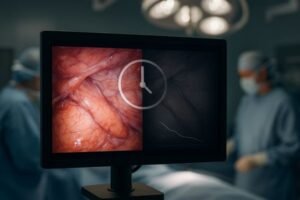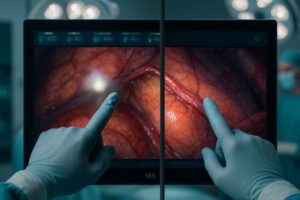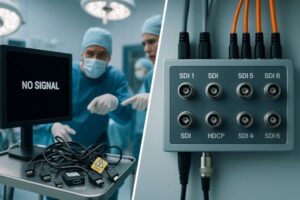In today’s complex operating rooms, surgeons often need to monitor multiple video feeds simultaneously—from the endoscope to patient vitals, and even radiological images. Juggling these on separate screens or constantly switching views can lead to a cluttered environment, potential distractions, and wasted critical time. This visual complexity can compromise focus, slow down procedures, and even introduce risks if crucial information is missed or delayed.
The Reshin MS550P 55-inch 4K surgical monitor supports versatile multi-signal display modes including Picture-in-Picture (PiP), Picture-by-Picture (PbP) in various configurations (e.g., dual, triple, quad split), and Quad View. These modes allow simultaneous display of multiple input sources like endoscopic cameras, patient vitals, and radiological images, providing a comprehensive overview on a single large screen for enhanced surgical decision-making.

I’ve personally witnessed how these advanced display capabilities can transform surgical workflows. Let’s delve into how these different modes cater to the diverse and demanding needs of modern surgical procedures.
How does Reshin enable flexible signal layouts?
Managing various video inputs during surgery can be a real challenge. Cluttered screens or the need to constantly switch between different monitors can easily distract the surgical team from their primary focus: the patient.
Reshin’s MS550P enables flexible signal layouts through its advanced image processing capabilities, allowing users to easily configure PiP, PbP, and Quad View modes via an intuitive interface, supporting various combinations of video inputs effectively.

At Reshin, we understand that multi-signal display modes1 aren’t just technical features; they directly impact how safely and efficiently surgeries are performed. The core of the Reshin MS550P‘s ability to manage these layouts lies in its sophisticated internal image processing hardware and software. This allows for the seamless integration and scaling of multiple video feeds onto the large 55-inch 4K screen. Surgeons or OR technicians can typically select and arrange these layouts through an intuitive on-screen display menu, often controlled via a remote or integrated OR control systems. This ease of use is vital, as Dr. Emily Chen, Chief Surgeon at Hong Kong United Hospital, would attest, given her need for seamless integration with OR towers and past frustrations with cumbersome display performance. Our monitors support a variety of input sources, commonly including multiple HDMI, DisplayPort, and SDI connections, ensuring compatibility with a wide range of OR equipment, from endoscopic cameras to C-arms and patient monitoring systems. Users can often customize window sizes and positions within certain modes, tailoring the view to the specific needs of the procedure. This adaptability ensures the MS550P can meet diverse surgical demands, from minimally invasive procedures to complex multi-specialty operations.
| Display Mode | Description | Common Inputs Displayed | Primary Benefit |
|---|---|---|---|
| Single Full Screen | One source occupies the entire display | Main endoscopic camera, primary imaging modality | Maximum detail for the primary surgical view |
| PiP (Picture-in-Picture) | One primary source with a smaller secondary overlay | Endoscope + Vitals, Endoscope + Ultrasound | Critical secondary info without losing main focus |
| PbP (Picture-by-Picture) | Two or more sources displayed side-by-side | Endoscope + Navigation, Pre-op + Live Image | Direct comparison, simultaneous monitoring |
| Quad View | Screen split into four equal segments | Multiple camera angles, vitals, imaging, PACS | Comprehensive overview for team procedures |
How does PiP mode enhance surgical efficiency?
During surgery, the primary visual focus is paramount, yet secondary information like patient vitals or auxiliary imaging can be equally critical. Constantly shifting gaze between different screens is inefficient and can be risky.
PiP mode on the Reshin MS550P enhances surgical efficiency by overlaying a smaller secondary video feed (e.g., patient vitals, ultrasound) onto the primary endoscopic view, keeping crucial data accessible without obstructing the main image.

Picture-in-Picture (PiP) mode2 is a powerful tool for enhancing situational awareness without compromising the surgeon’s focus on the primary operative field. On the Reshin MS550P, this typically means the main endoscopic or surgical camera feed3 occupies the majority of the screen, while a smaller, scalable window displays a secondary source. This secondary source could be live patient vitals, an intraoperative ultrasound image, a fluoroscopy feed, or even a view from a second camera. I recall a discussion with Alex Müller from Mediview Technologies GmbH, who emphasized his clients’ need for imaging systems that avoid any form of lag or inconsistency; a smoothly integrated PiP is part of that expectation. The beauty of PiP is that it allows the surgeon to maintain constant visual contact with the main surgical site while having immediate access to this supplementary information. The size and position of the PiP window can usually be adjusted to ensure it doesn’t obstruct a critical part of the primary view. This reduces the need for head movement to look at a separate monitor, saving precious seconds and minimizing distractions. In minimally invasive procedures4, for example, a surgeon might have the laparoscopic view as primary, with a PiP window showing the output from a nerve monitoring system. This integrated view allows for quicker responses to any changes in the secondary data, ultimately contributing to a more efficient and potentially safer procedure. Our goal is to help surgical teams focus more on the patient and less on managing the equipment.
When should PbP mode be used in operations?
Certain surgical scenarios demand equal attention to multiple, distinct visual sources. Constantly toggling between full-screen views of these sources is slow, can break the surgeon’s concentration, and may lead to information being missed.
PbP mode on the MS550P should be used when surgeons need to compare or simultaneously monitor two or more significant video sources side-by-side, such as different camera views or pre-operative and live surgical images.

Picture-by-Picture (PbP) mode5 is invaluable when two or more video sources require comparable visual prominence. The Reshin MS550P, with its expansive 55-inch 4K screen, truly excels here, offering ample real estate to display multiple feeds without significant compromise in size or clarity for each. In PbP mode, the screen is typically split into two, three, or sometimes four vertical or horizontal segments, each displaying a different input. A common application is the side-by-side comparison of pre-operative imaging (like an MRI or CT scan) with the live intraoperative view. This is crucial in procedures like neurosurgery or complex oncological resections, where precise anatomical correlation is key. Another use case involves displaying feeds from two different endoscopic cameras simultaneously, for example, a 0-degree and a 30-degree scope, or feeds from different ports in a multi-port robotic surgery. The large format of the MS550P ensures that even when split, each window provides a sufficiently large and detailed image. This is particularly important because, as I’ve always stressed, stable signal synchronization and the ability to clearly see all necessary information are crucial for real-time decision-making. Dr. Emily Chen’s advanced surgical departments, such as cardiology or hepatobiliary surgery, often encounter complex cases where such simultaneous views can greatly enhance procedural accuracy and efficiency.
How is Quad View applied in team procedures?
Complex team surgeries, particularly in specialties like trauma or cardiothoracic surgery, often involve multiple specialists who each require different visual information simultaneously. A single, shared view is frequently insufficient for their coordinated efforts.
Quad View on the Reshin MS550P divides the 55-inch screen into four equal segments, displaying up to four distinct video sources simultaneously, ideal for team procedures where different specialists need to monitor various critical feeds.

The Quad View capability of the Reshin MS550P transforms it into a central information hub for team-based procedures. By dividing the large 55-inch 4K screen into four distinct quadrants, up to four different video sources can be displayed concurrently, each occupying a significant portion of the screen. This mode is exceptionally beneficial in complex surgeries where multiple specialists collaborate and need access to different data streams. For instance, in a cardiac surgery, the surgeon might be focused on the endoscopic view of the heart (Quadrant 1), the anesthesiologist on detailed patient vitals and ventilator settings (Quadrant 2), the perfusionist on data from the heart-lung machine (Quadrant 3), and a consulting radiologist or technician might be displaying relevant angiograms or echo images from PACS (Quadrant 4). This simultaneous display ensures that all key team members have immediate visual access to the information most relevant to their role, fostering better communication and coordinated decision-making. The sheer size and resolution of the MS550P are critical here, as they allow each quadrant to display a clear, detailed image without appearing cluttered. This setup is also highly valuable in teaching hospitals, allowing trainees to observe multiple facets of a complex procedure simultaneously. It directly addresses the need for adaptability in diverse surgical demands, a core insight from my experience.
How does mode switching affect clinical workflow?
Switching between different display modes or input sources mid-surgery can be highly disruptive if the process is slow, cumbersome, or results in signal loss. Such interruptions can break the surgical team’s flow and concentration.
Fast, intuitive mode switching on the Reshin MS550P minimizes disruption to clinical workflow, allowing seamless transitions between single-view, PiP, PbP, and Quad View as surgical needs dynamically evolve, ensuring uninterrupted real-time decision-making.

The ability to switch between display modes6 quickly and reliably is just as important as the modes themselves. In the dynamic environment of an operating room, the informational needs of the surgical team can change rapidly. For example, a surgeon might start a procedure with a full-screen endoscopic view, then switch to PiP to monitor vitals during a critical phase, and later move to PbP to compare with pre-operative scans. The Reshin MS550P is engineered for such seamless transitions. Our R&D team, with its extensive experience and numerous patents, focuses heavily on ensuring stable signal synchronization7 and fast switching. This means that when a mode change is initiated – typically via an intuitive on-screen menu, dedicated remote control buttons, or even integrated OR control systems – the transition is swift, without flickering, signal loss, or significant delay. This addresses a key pain point often experienced with less advanced systems: display performance issues during surgery. A smooth, reliable switching mechanism minimizes workflow disruptions, reduces potential frustration for the OR team, and allows them to maintain their focus on the patient. This is critical for real-time decision-making, ensuring that the technology supports, rather than hinders, the surgical process. This commitment to performance is why Reshin is trusted by global brands and used in so many hospitals worldwide.
Conclusion
The Reshin MS550P’s versatile multi-signal display modes—PiP, PbP, and Quad View—significantly enhance surgical visualization, facilitate better team collaboration, and improve overall OR efficiency, reflecting our ongoing commitment to advancing medical display technology.
Interested in upgrading your OR visualization? Contact us at martin@reshinmonitors.com to learn more about the MS550P and how Reshin can support your surgical needs.
- Learn how multi-signal display modes can significantly enhance the performance and safety of surgical operations. ↩
- Explore how PiP mode enhances surgical efficiency and safety by providing real-time data without distractions. ↩
- Learn about the importance of high-quality surgical camera feeds in enhancing visibility and precision during operations. ↩
- Discover the benefits of minimally invasive techniques, including reduced recovery time and improved patient outcomes. ↩
- Understanding PbP mode can enhance your knowledge of video display technology, especially in medical applications. ↩
- Understanding various display modes can enhance surgical efficiency and improve patient outcomes. Explore this link for detailed insights. ↩
- Signal synchronization is crucial for seamless transitions in surgery. Learn more about its importance and applications in this informative resource. ↩



